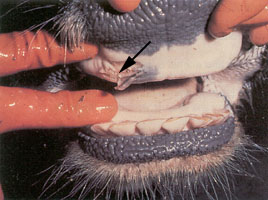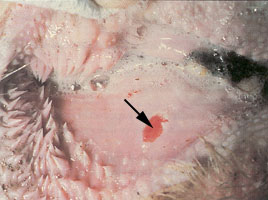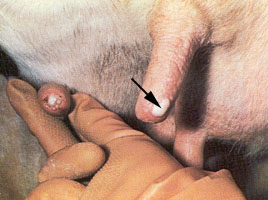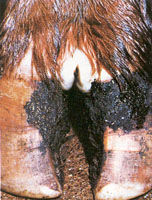

|
Ruptured vesicles and ulcers in the mouth |
Introduction:
Foot-and-mouth disease (FMD) is a viral disease of cloven-hoofed animals such as sheep, goats, cattle, and deer. The United States has been free of FMD since 1929. However, many countries throughout the world are NOT considered FMD free. Because the disease spreads easily and rapidly, this is a major concern for areas and countries that are currently FMD-free. This disease is considered to be the most economically devastating livestock disease in the world. FMD is not contagious to humans and therefore is not considered a zoonotic disease.Causative Agent:
FMD is caused by a virus (there are at least seven different types and many subtypes of this virus). If an animal develops immunity to one type of the virus, this does NOT protect the animal against the other types. The virus can survive in the environment for up to one month, depending on the temperature and pH conditions.Clinical Signs:
FMD can cause the animal to have very thick, stringy saliva and a loss of appetite because of the painful mouth lesions. This disease causes a fever and blister-like lesions (vesicles) on the mouth, tongue, lips, teats, and between the hooves. These vesicles eventually rupture leaving a very painful, red ulcer or erosion. This problem can also cause weight loss, lameness, decreased milk production, and abortions. Most animals do NOT die because of the disease, but they often never return to normal production levels.Disease Transmission: FMD is highly contagious and can be spread by animals, people, or contaminated materials (clothing, gloves, shoes, instruments, truck tires, etc.) that bring the virus into physical contact with susceptible animals. The following list contains some of the common ways of spreading the disease:
|
|
|
|

|
|

|
|
All pictures are of cattle and have been used by permission from the USDA
.Diagnosis:
Because this disease can look like other conditions and diseases, diagnosing FMD based only on clinical signs is difficult. Laboratory analysis of blood, fluid, and tissue samples is required to confirm a diagnosis. Handling of these samples can be complicated; therefore, if a case of FMD is suspected, a local and state veterinarian should be contacted immediately.Other diseases that look like FMD include bluetongue, footrot, and lesions of the mouth/tongue caused by plant material (grass awns) and equipment (balling guns, etc.).
Prevention: Because the United States’ sheep and goat populations have not been exposed to this disease, they are extremely vulnerable to infection. In the United States, preventing FMD centers around keeping the virus from entering the country and detecting the disease early if it happens to appear. The following are things that can and are being done to prevent this disease from entering the United States:
The following actions are a must for every veterinarian, producer, and livestock owner to help prevent an outbreak of FMD in the United States:
| Product | Mixing Instructions |
| Bleach | Add 3 gallons of bleach to 2 gallons of water -then mix thoroughly |
| Virkon-S (Antec) |
Follow label directions |
| Oxycept-333 (Ecolab) |
Add 4 oz. to 8 gallons of water |
Additional general biosecurity information can be found on page B76.
Vaccination:
There is a vaccine for FMD; however, the vaccine is not currently used in the United States. This is mainly because of 3 reasons:If an outbreak ever occurred in the United States, vaccination could play an important role in the control of the disease. USDA officials, along with local and state authorities, could design a vaccination program specific to the area and type of outbreak. This is important because there are so many different types and subtypes of FMD that no universal vaccine against the disease exists. Currently, the North American FMD Vaccine Bank stores the different types of inactivated FMD antigen (virus). Should an FMD outbreak occur, these antigens could be rapidly formulated into a vaccine specific to the type of virus causing the outbreak.